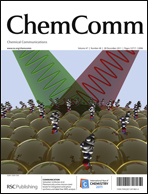A highly efficient kinetic resolution of Morita–Baylis–Hillman adducts achieved by N–Ar axially chiral Pd-complexes catalyzed asymmetric allylation†
Abstract
Palladium complexes with an axially chiral N–Ar framework have been developed. These complexes showed high stereoselectivities in asymmetric allylic arylation to achieve the kinetic resolution of Morita–Baylis–Hillman adducts, affording up to 99% ee of (E)-allylation products and 92% ee of recovered Morita–Baylis–Hillman adducts.


 Please wait while we load your content...
Please wait while we load your content...